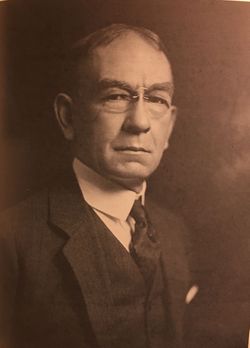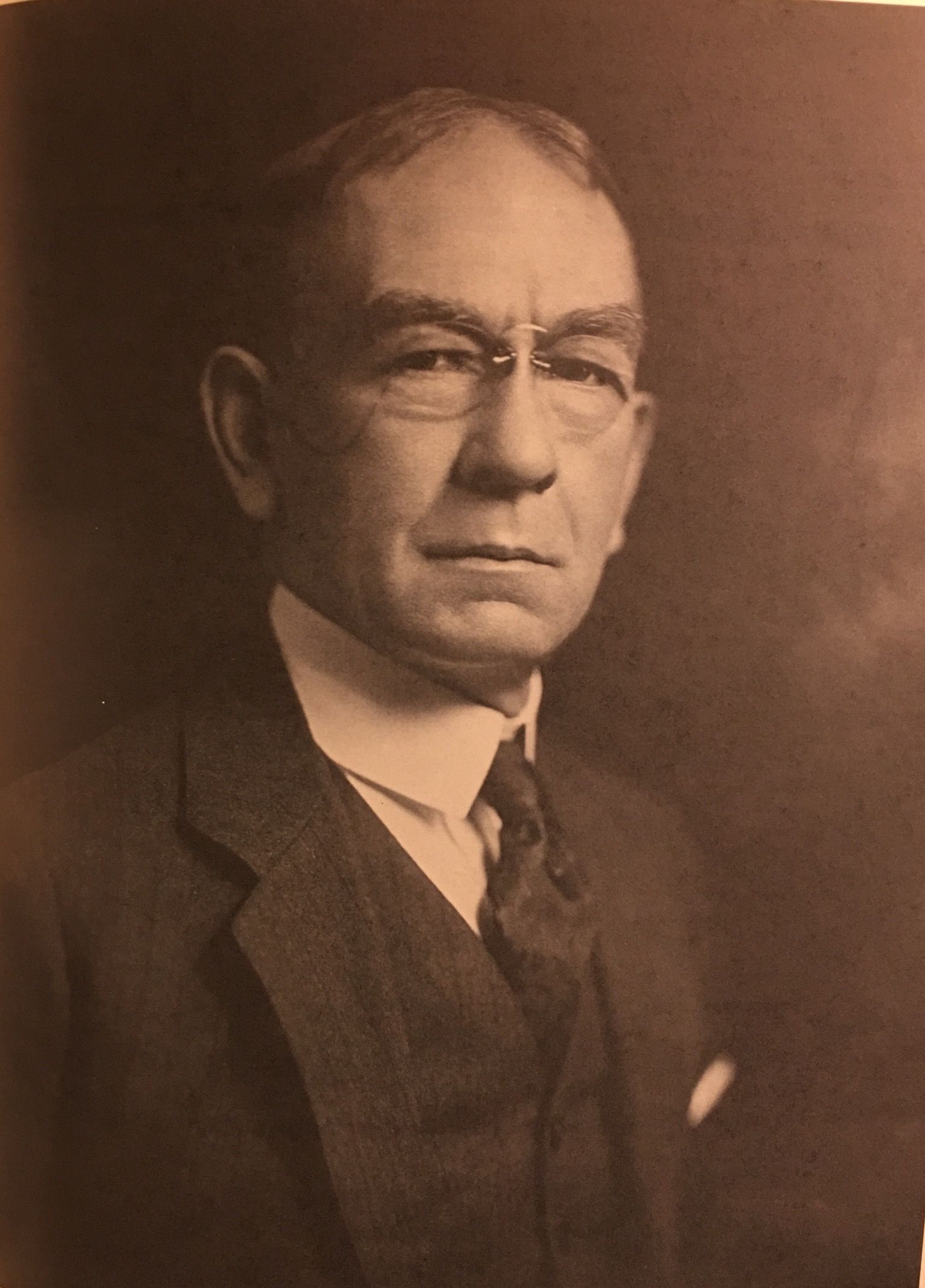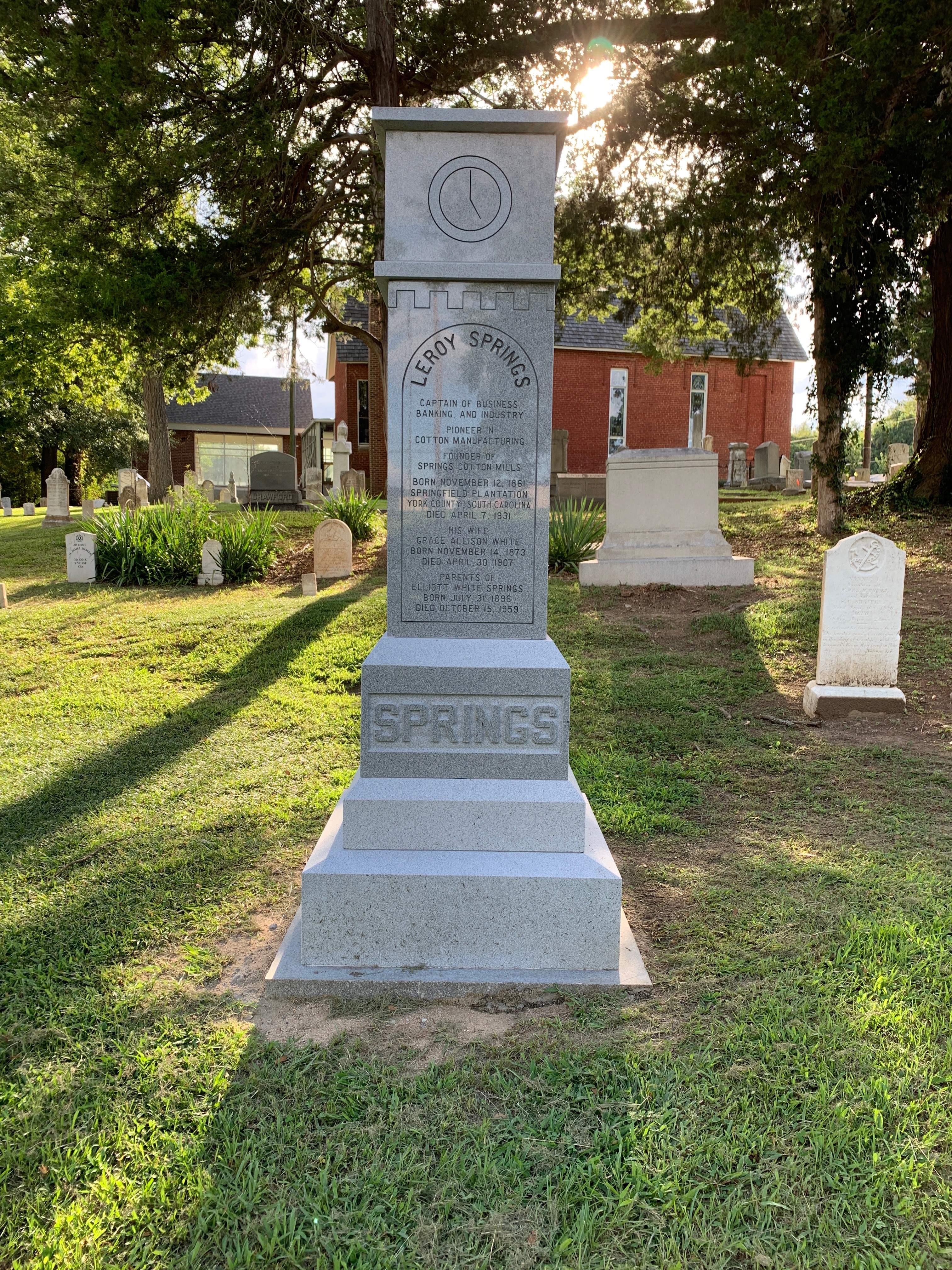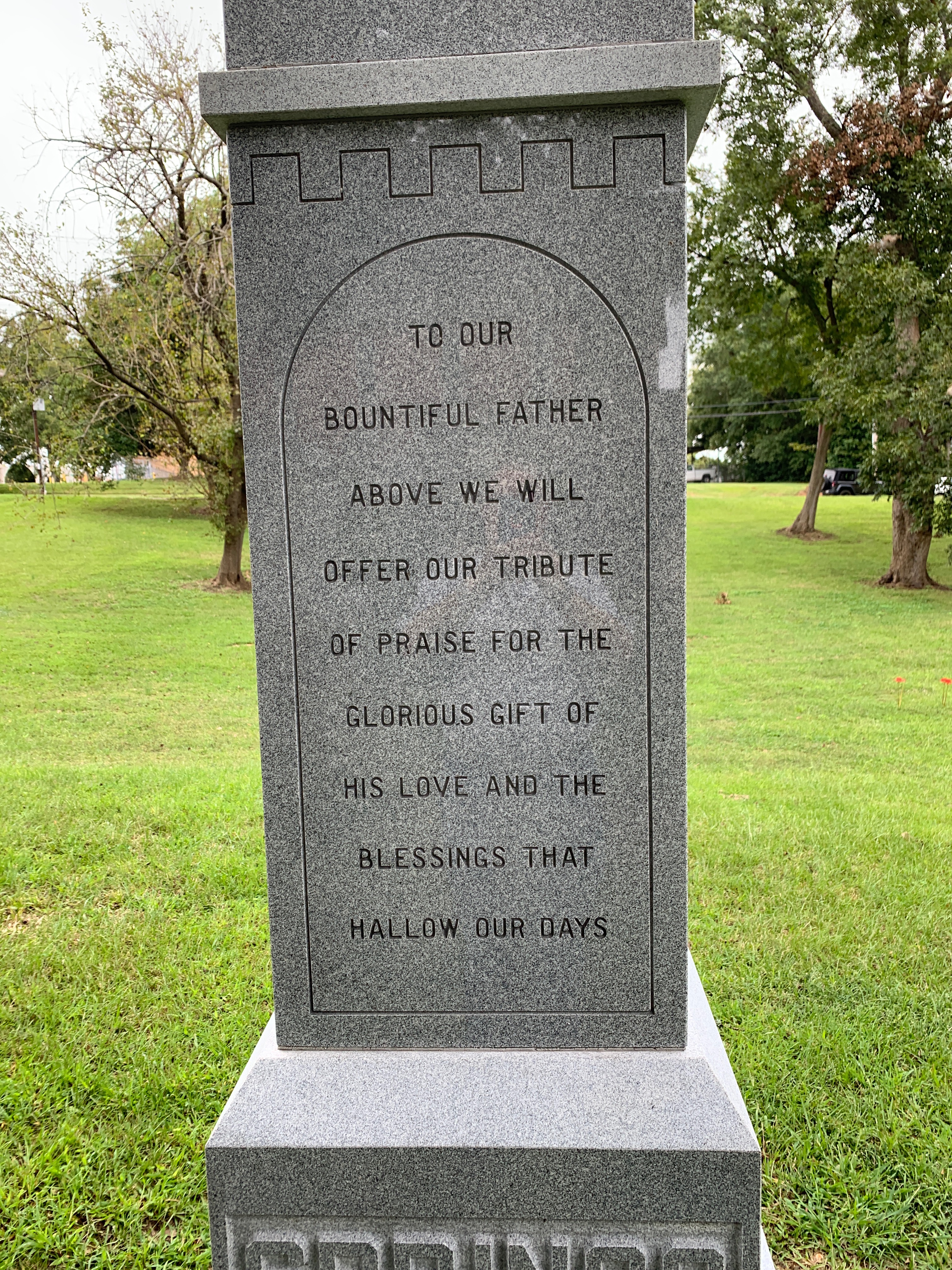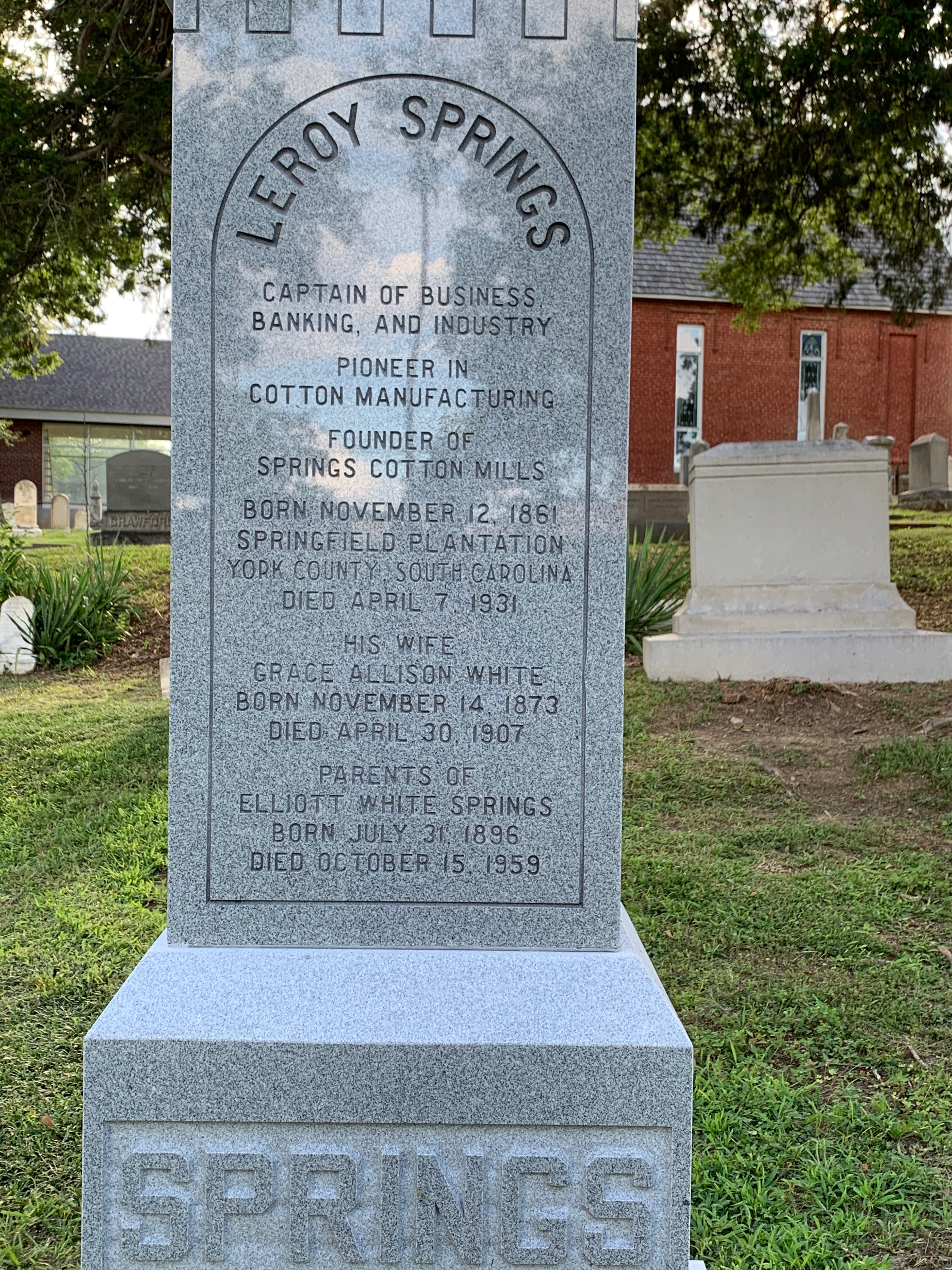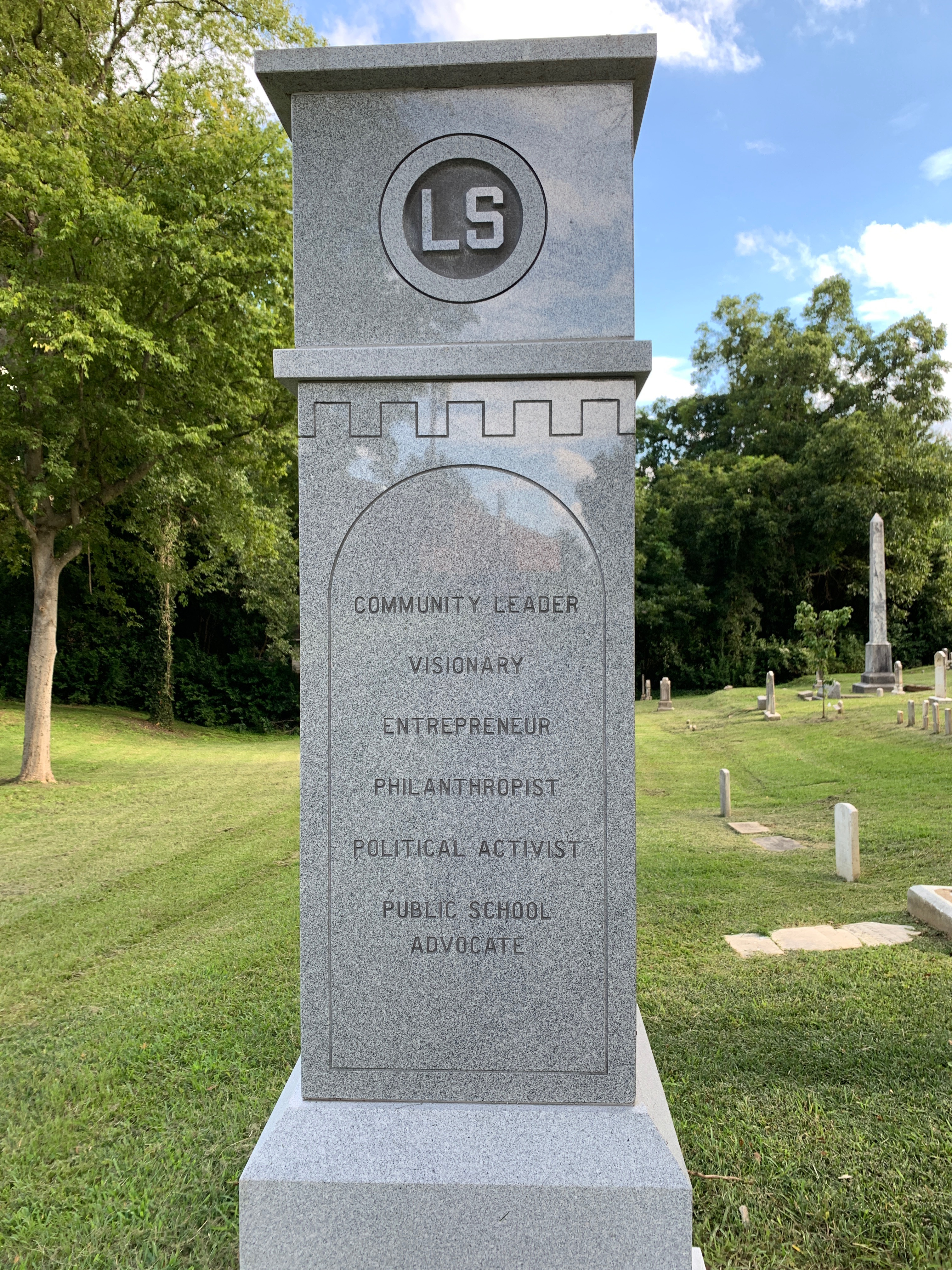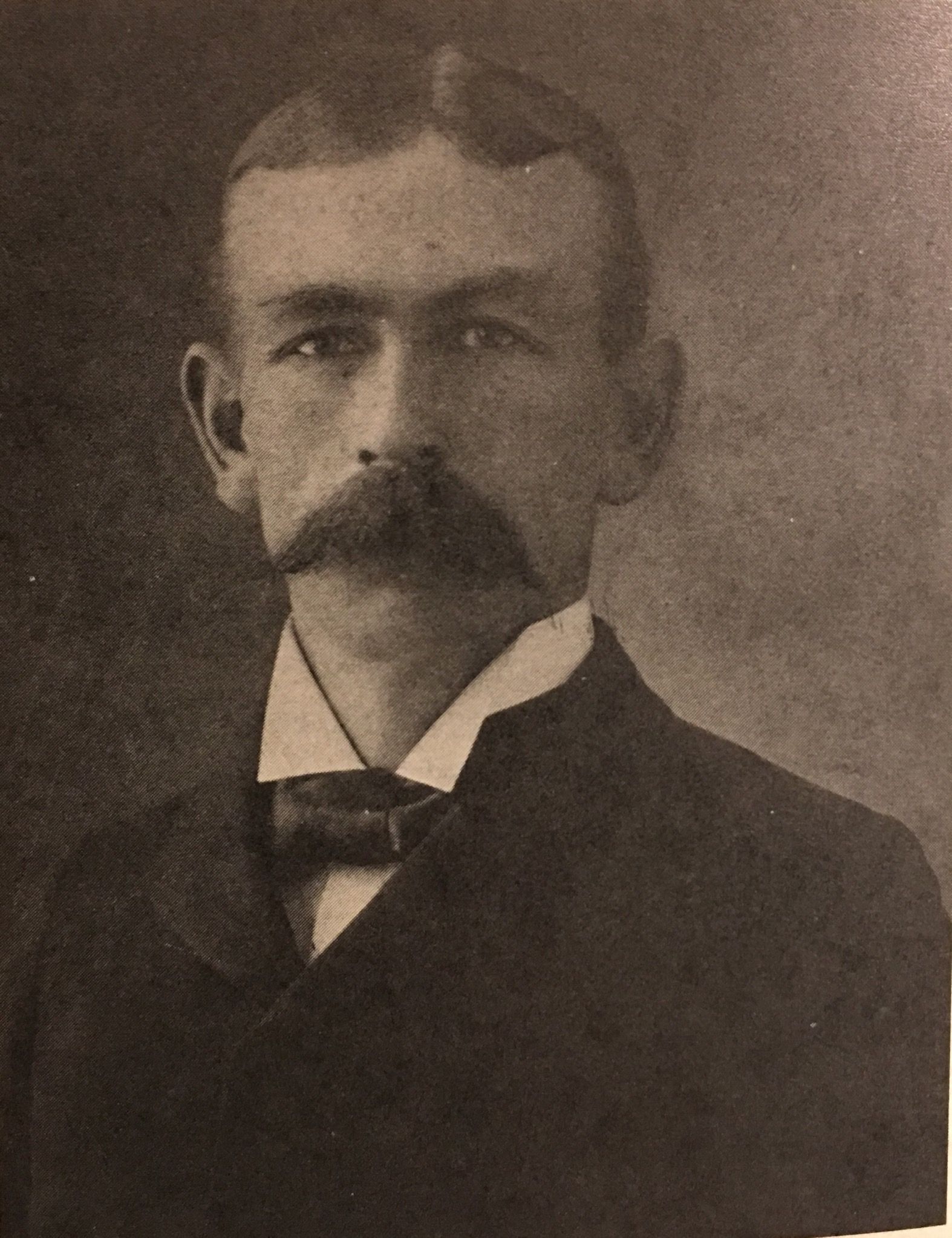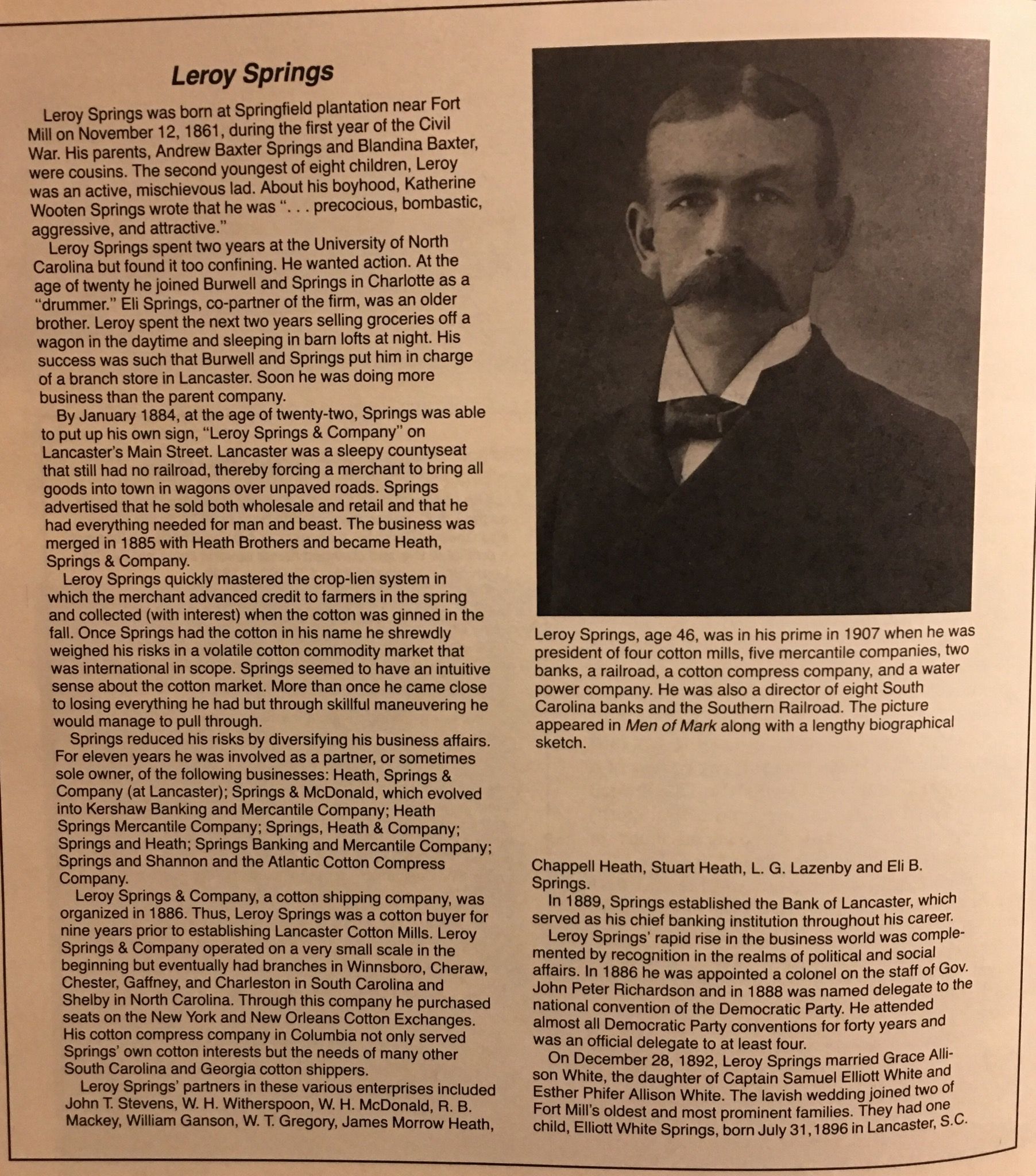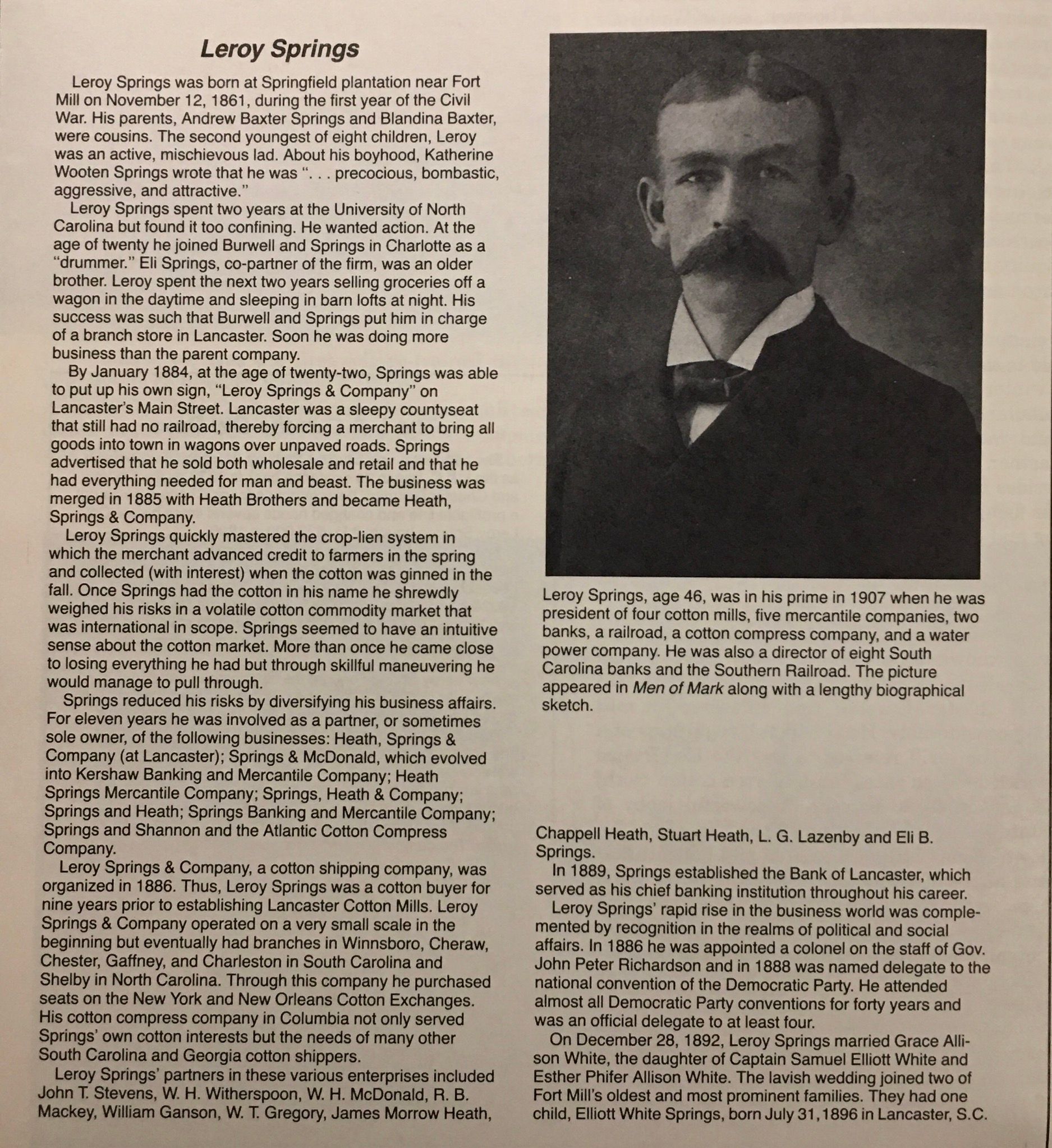Please see FAG 86514872 Which is now a Cenotaph memorial.
————————————————————
BRIAN MELTON/The Lancaster News
The textile magnate’s gravestone in the historic Olde Presbyterian Church Cemetery is proportionate to its setting. At 8 feet tall and 3½ feet wide at the base, it is about the same size as the cemetery’s other large monuments.
His burial vault was moved to the historic church cemetery in March 2019 by the Lancaster County Society for Historical Preservation after its location was discovered on the old mill property.
The mill was demolished in 2004, and the society’s board worried that an important piece of county history could be lost with the eventual redevelopment of the property.
“The marker is a clock, so it has to tell some time,” said local attorney and historical society board member Robert Folks. “It shows 5 o’clock because that’s when his funeral was held.”
Leroy Springs was originally entombed on April 10, 1931, on the front lawn of his Lancaster Cotton Mill, beneath the shadow of its clock tower.
His remains were moved to the historic church cemetery after some cloak-and-dagger work and hit-and-miss digging by the historical society to find the location.
His remains were placed at the Olde Presbyterian Church because it is on the National Register of Historic Places. Its cemetery holds notable citizens dating back to 1836.
Folks said the idea of making Springs’ gravestone resemble a clock tower came from Arras Foundation intern Tanner Knight.
“I thought, ‘Darn, what a good idea. I wish I had it.’ The historical society wanted it to be an obelisk to make it look like others in the cemetery,” Folks said. “It must’ve been a good idea, because after Tanner came up with it, somebody else told me the same thing the very next week.”
The essence of the 40-foot clock tower that graced the old mill is still around. The clock mechanism was dismantled in 2003 and rebuilt on the grounds of Founders Federal Credit Union’s corporate center at Plantation and Gillsbrook roads in 2009, using 4,000 of the original cotton mill bricks.
Folks said a commemorative service in Leroy Springs’ honor will be held next spring, after construction wraps up on the expansion of the adjacent church building, which is now the Lancaster Cultural Arts Center.
Contributor: agagee (47880557)∼Son of Andrew Baxter and Julia Blandina Baxter Springs. Colonel Springs married (1) Grace Allison White, and (2) Lena May Jones.
"Colonel Leroy Springs, one of the foremost pioneers in cotton manufacturing was equally prominent is banking, cotton oil, rail and insurance. During his day, he may have been the busiest textile executive of them all.
He was born on Springfield Plantation, near Fort Mill, SC, just south of Charlotte, NC, on November 12, 1861, a son of A. Baxter Springs and Julia Blandina (Baxter) Springs. His father was a lawyer but more importantly, a planter on a large scale; president of a railroad; director of two other railroads; and interested in banking. His father became a state senator and was a member of the South Carolina Convention, which formed the ordinance of secession. He was a student at the University of North Carolina from 1878-1880. After the university, he entered the mercantile business and became a salesman for a Charlotte wholesale grocery firm. This began a long, successful career in business. He married Grace Allison White, daughter of Samuel E. White of Fort Mill, in 1891. She died in 1907. He began his own business, Leroy Springs and Company in Lancaster, SC in 1884. He organized the Kershaw, SC Mercantile and Banking Co. in 1888. Many other banking ventures followed.
Springs entered textiles late in his career. He organized the Lancaster Cotton Mills, one of the largest in the South in 1896; the Eureka Cotton Mills and Springstein Mills in 1899; and Kershaw in 1904. He reorganized the two mills of what would become the most famous location, Fort Mill Manufacturing Company in 1904. These mills, founded in 1884 and 1889 became the central location of what grew into a dynamo in the 20th
century.
He served as Colonel on the staff of Governor John P. Richardson from 1886 until 1890. He was Chairman of the Board of Trustees of the Lancaster Grade School for a period. He was a delegate to the Democratic National Convention four successive times up to 1920, and a delegate-at-large in 1924.
In 1928, toward the end of his career, he was president of seven cotton mill companies, president of the Bank of Lancaster, the Lancaster and Chester Railway, the Lansford Water and Power Company of Lancaster;Vice-President of the Bank of Kershaw; Director of the Catawba Fertilizer Co., the Lancaster Cotton Oil Co., First National Bank of Camden, National Exchange Bank of Kershaw, Savings bank of Fort Mill, the Southern Home Fire Insurance Co. of Charleston, the Prudential Fire Insurance Co. of Greenville, Trustee of the Mutual Life Insurance Co. of New York,; Director of the American Trust Co. of Charlotte; Vice-President of the Columbia, SC National Bank. He was a director of the Charleston, Columbia and Augusta Rail way at the time it merged with the Southern Railway. He was probably officially connected with more separate corporations than any one businessman in the state of South Carolina.
He died in 1931 and turned over the textile business to his son, Colonel Elliot White Springs, a distinguished World War I flying ace and entrepreneur who really put Springs textiles on the national map with imaginative advertising and outlandish quotes." - Jacobs, William Plumer 1935 The Pioneer Clinton, SC Jacobs & Co. Press.
Please see FAG 86514872 Which is now a Cenotaph memorial.
————————————————————
BRIAN MELTON/The Lancaster News
The textile magnate’s gravestone in the historic Olde Presbyterian Church Cemetery is proportionate to its setting. At 8 feet tall and 3½ feet wide at the base, it is about the same size as the cemetery’s other large monuments.
His burial vault was moved to the historic church cemetery in March 2019 by the Lancaster County Society for Historical Preservation after its location was discovered on the old mill property.
The mill was demolished in 2004, and the society’s board worried that an important piece of county history could be lost with the eventual redevelopment of the property.
“The marker is a clock, so it has to tell some time,” said local attorney and historical society board member Robert Folks. “It shows 5 o’clock because that’s when his funeral was held.”
Leroy Springs was originally entombed on April 10, 1931, on the front lawn of his Lancaster Cotton Mill, beneath the shadow of its clock tower.
His remains were moved to the historic church cemetery after some cloak-and-dagger work and hit-and-miss digging by the historical society to find the location.
His remains were placed at the Olde Presbyterian Church because it is on the National Register of Historic Places. Its cemetery holds notable citizens dating back to 1836.
Folks said the idea of making Springs’ gravestone resemble a clock tower came from Arras Foundation intern Tanner Knight.
“I thought, ‘Darn, what a good idea. I wish I had it.’ The historical society wanted it to be an obelisk to make it look like others in the cemetery,” Folks said. “It must’ve been a good idea, because after Tanner came up with it, somebody else told me the same thing the very next week.”
The essence of the 40-foot clock tower that graced the old mill is still around. The clock mechanism was dismantled in 2003 and rebuilt on the grounds of Founders Federal Credit Union’s corporate center at Plantation and Gillsbrook roads in 2009, using 4,000 of the original cotton mill bricks.
Folks said a commemorative service in Leroy Springs’ honor will be held next spring, after construction wraps up on the expansion of the adjacent church building, which is now the Lancaster Cultural Arts Center.
Contributor: agagee (47880557)∼Son of Andrew Baxter and Julia Blandina Baxter Springs. Colonel Springs married (1) Grace Allison White, and (2) Lena May Jones.
"Colonel Leroy Springs, one of the foremost pioneers in cotton manufacturing was equally prominent is banking, cotton oil, rail and insurance. During his day, he may have been the busiest textile executive of them all.
He was born on Springfield Plantation, near Fort Mill, SC, just south of Charlotte, NC, on November 12, 1861, a son of A. Baxter Springs and Julia Blandina (Baxter) Springs. His father was a lawyer but more importantly, a planter on a large scale; president of a railroad; director of two other railroads; and interested in banking. His father became a state senator and was a member of the South Carolina Convention, which formed the ordinance of secession. He was a student at the University of North Carolina from 1878-1880. After the university, he entered the mercantile business and became a salesman for a Charlotte wholesale grocery firm. This began a long, successful career in business. He married Grace Allison White, daughter of Samuel E. White of Fort Mill, in 1891. She died in 1907. He began his own business, Leroy Springs and Company in Lancaster, SC in 1884. He organized the Kershaw, SC Mercantile and Banking Co. in 1888. Many other banking ventures followed.
Springs entered textiles late in his career. He organized the Lancaster Cotton Mills, one of the largest in the South in 1896; the Eureka Cotton Mills and Springstein Mills in 1899; and Kershaw in 1904. He reorganized the two mills of what would become the most famous location, Fort Mill Manufacturing Company in 1904. These mills, founded in 1884 and 1889 became the central location of what grew into a dynamo in the 20th
century.
He served as Colonel on the staff of Governor John P. Richardson from 1886 until 1890. He was Chairman of the Board of Trustees of the Lancaster Grade School for a period. He was a delegate to the Democratic National Convention four successive times up to 1920, and a delegate-at-large in 1924.
In 1928, toward the end of his career, he was president of seven cotton mill companies, president of the Bank of Lancaster, the Lancaster and Chester Railway, the Lansford Water and Power Company of Lancaster;Vice-President of the Bank of Kershaw; Director of the Catawba Fertilizer Co., the Lancaster Cotton Oil Co., First National Bank of Camden, National Exchange Bank of Kershaw, Savings bank of Fort Mill, the Southern Home Fire Insurance Co. of Charleston, the Prudential Fire Insurance Co. of Greenville, Trustee of the Mutual Life Insurance Co. of New York,; Director of the American Trust Co. of Charlotte; Vice-President of the Columbia, SC National Bank. He was a director of the Charleston, Columbia and Augusta Rail way at the time it merged with the Southern Railway. He was probably officially connected with more separate corporations than any one businessman in the state of South Carolina.
He died in 1931 and turned over the textile business to his son, Colonel Elliot White Springs, a distinguished World War I flying ace and entrepreneur who really put Springs textiles on the national map with imaginative advertising and outlandish quotes." - Jacobs, William Plumer 1935 The Pioneer Clinton, SC Jacobs & Co. Press.
Gravesite Details
Originally buried on the lawn of Lancaster Cotton Mills, Colonel Springs was exhumed on March 27, 2019 and reburied the next day at Olde Presbyterian Church Cemetery.
Family Members
Sponsored by Ancestry
Advertisement
Explore more
Sponsored by Ancestry
Advertisement
